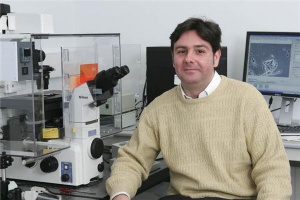Mar 17 2009
The roots of synthetic biology stretch back only eight years, and the discipline is so new that it does not yet have an established definition. On the one hand, it can be considered from a microscopic and fundamental perspective - to a certain extent more closely related to chemistry - as the synthesis of new, biologically important molecules (for example, nucleotides). Alternatively, it can be considered at the organism level, understood as the creation of new life forms (such as viruses).
 Jordi García Ojalvo is one of a group of Spanish researchers who have spent the last six years working on synthetic biology and systems biology.
Jordi García Ojalvo is one of a group of Spanish researchers who have spent the last six years working on synthetic biology and systems biology.
The area between these two areas of research is occupied by a sub-discipline that is “more promising, in that it can help us to understand living systems, focusing on the creation of new genetic circuits – formats for genes and proteins that are connected by complex interactions – that can be integrated into cells to alter their function from that which they would perform in their original context, and the standardization of these circuits so that they can then be combined”, explains Jordi García Ojalvo, a researcher for the Department of Physics and Nuclear Engineering working at the UPC's campus in Terrassa.
One of the current aims of biology researchers is to determine the operation of the genetic circuits that regulate cell activity, a problem that can be solved by adopting an approach derived from engineering. As García Ojalvo explains, “If you want to understand how something works, that is, how a cell carries out a specific task, construct a circuit that does the same thing”. In his view, 'hard science', which primarily involves the study of inert matter, can also play an important role in the study of living matter.
A researcher with a background in hard science, who understands how these mechanisms function in other types of systems, has the skills required to select a circuit, create a mathematical model using computer simulation and analyze its function. This would make it possible to determine the conditions a circuit requires to perform a specific task. Moreover, a number of techniques and devices used in synthetic biology require the expertise of physicists and engineers, for example, ensuring that cells are handled in a carefully regulated environment (microfluidic control), and providing a high degree of optical precision. The knowledge and data that traditional biologists can provide is also important. As such, synthetic biology is widely considered to be inherently cross-disciplinary.
Although it is a new branch of scientific study, scientists working in synthetic biology did not have to start from scratch, and have been able to draw on decades of work carried out in fields such as genetic engineering, molecular biology and, more recently, systems biology. Specific milestones that have contributed to the development of synthetic biology include the discovery of the green fluorescent protein and its use as a marker in the analysis of various processes in all areas of biology, which is now a standard technique that enables scientists to observe the responses of individual cells to different actions and monitor their status in real time.
An enhanced version of nature
One of the most novel aspects of this discipline is its inherent capacity for a key concept: standardization. To draw a comparison with electronics, in the same way that a hard disk can be connected to any computer, so genetic circuits can be integrated into any cell to prompt a specific task.
Given the difficulties of analyzing the complex genetic circuits found in nature, synthetic biology offers an alternative approach to the problem: construct the simplest circuits possible, determine how they function, and increase the level of complexity step by step. Since research of this type focuses on simple circuits, involving only two or three genes, it is possible to develop mathematical models that are not only capable of predicting cell behavior in terms of the degree of protein production but can also induce specific dynamics.
This was first achieved in 2000 by a research group directed by Michael Elowitz, at the California Institute of Technology (Caltech), which constructed the first oscillator, or synthetic genetic clock. This breakthrough, which effectively marked the inception of synthetic biology as a discipline, demonstrated that cells have a built-in 'clock' which enables them to calculate time and synchronize to perform predetermined actions simultaneously.
Since then, research in this field in Spain has been carried out jointly with groups such as the UPC's Research Group on Nonlinear Dynamics, Nonlinear Optics and Lasers (DONLL), based at the Terrassa campus, coordinated by Ramon Vilaseca and formed by researchers including García Ojalvo. The group has spent six years working in the fields of synthetic biology and systems biology, first concentrating on theory and then moving into experimental work in the last two years. Research conducted in collaboration with the Elowitz group at Caltech and a group coordinated by Gurol Suel of the University of Texas Southwestern Medical Center at Dallas focuses on understanding differentiation processes (such as state changes) in bacteria, which are model organisms that can be used to study functions performed in more complex organisms.
The DONLL team is also working with a research group coordinated by Alfonso Martínez Arias, of the University of Cambridge, to understand the process by which embryonic stem cells maintain multipotentiality, which is the mechanism through which they conserve the capacity to differentiate into any type of cell. In this specific area, researchers do not use synthetic biology per se – they do not construct circuits, for example – but try to analyze the way in which natural circuits function. Although the work of the DONLL group is not yet targeted at a specific application, the general objective is to develop the capability to control cell behaviour externally.